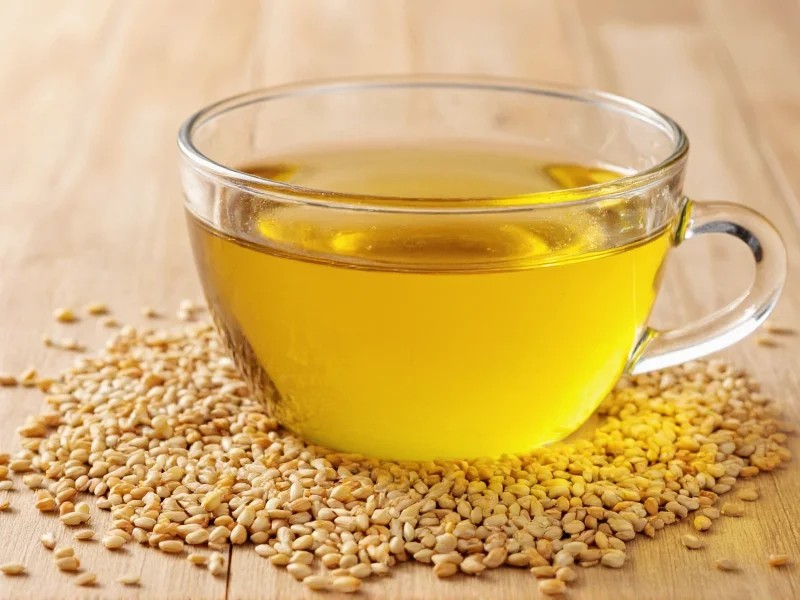Understanding Sesame Oil: Properties and Production
Sesame oil has been used for thousands of years across Asian, Middle Eastern, and African culinary traditions. The oil extraction process determines its flavor profile and culinary applications. Light sesame oil undergoes minimal processing, preserving its high smoke point (around 410°F/210°C), making it suitable for frying and sautéing. Toasted sesame oil, by contrast, is made from roasted seeds, yielding a lower smoke point (350°F/175°C) but intense flavor perfect for dressings and finishing dishes.
Types of Sesame Oil Compared
| Type | Processing Method | Smoke Point | Best Culinary Uses | Flavor Profile |
|---|---|---|---|---|
| Light/Unrefined | Cold-pressed or expeller-pressed | 410°F (210°C) | Frying, stir-frying, baking | Mild, neutral |
| Toast/Dark | Seeds roasted before pressing | 350°F (175°C) | Finishing oil, dressings, marinades | Rich, nutty, aromatic |
| Blended | Mixed with other oils | Varies | General cooking | Moderate sesame flavor |
Nutritional Composition and Health Considerations
When evaluating is sesame oil healthy, research shows it contains approximately 40% monounsaturated fats (oleic acid) and 42% polyunsaturated fats (linoleic acid), with only 14% saturated fat. The presence of sesamol and sesamin antioxidants contributes to its stability and potential health benefits. Studies published in the Journal of Nutrition and Metabolism indicate sesame oil may support cardiovascular health when used as part of a Mediterranean-style diet.
Regarding is sesame oil inflammatory, current evidence suggests the opposite. The omega-6 fatty acids in sesame oil (about 42%) are balanced by anti-inflammatory compounds like lignans. While excessive omega-6 consumption from processed foods can promote inflammation, whole-food sources like sesame oil appear to have neutral or beneficial effects when consumed in appropriate portions.
Culinary Applications and Best Practices
Professional chefs emphasize understanding is sesame oil good for cooking depends on the variety and application. Light sesame oil works well for high-heat methods, while toasted sesame oil should never be used for frying as heat destroys its delicate flavor compounds. For authentic Asian dishes, combine both types: use light oil for cooking and add toasted oil at the end for flavor enhancement.
When substituting oils, remember that is sesame oil high in omega 6 makes it nutritionally similar to sunflower or soybean oil, but with superior flavor complexity. For those asking is sesame oil gluten free, the answer is definitively yes, as it's derived solely from sesame seeds with no grain components.
Storage Recommendations and Shelf Life
Sesame oil's shelf life depends on proper storage. Light sesame oil remains stable for 6-12 months when stored in a cool, dark place, while toasted sesame oil lasts 3-6 months due to its roasted nature. Refrigeration extends shelf life but may cause cloudiness (reversible at room temperature). Always check for rancidity by smelling for any paint-like or bitter odors before use.
Common Misconceptions Clarified
Many wonder is sesame oil good for skin and hair. While traditional medicine uses it topically, scientific evidence for significant cosmetic benefits is limited. The oil's fatty acid profile resembles skin lipids, making it a reasonable carrier oil, but it shouldn't replace clinically proven skincare treatments. Similarly, is sesame oil good for hair lacks strong scientific backing, though its emollient properties may temporarily improve hair texture.
Frequently Asked Questions
Is sesame oil safe for people with nut allergies?
Yes, sesame oil is generally safe for those with tree nut or peanut allergies since sesame seeds are not nuts. However, sesame itself is a common allergen, so individuals with sesame allergies must avoid it completely. Always check product labels for potential cross-contamination warnings.
Can I use sesame oil for high-heat cooking?
Light/unrefined sesame oil has a smoke point of 410°F (210°C), making it suitable for stir-frying and sautéing. However, toasted sesame oil has a much lower smoke point (350°F/175°C) and should only be used as a finishing oil added after cooking to preserve its flavor and nutritional properties.
Does sesame oil need refrigeration after opening?
Refrigeration extends sesame oil's shelf life but isn't strictly necessary. Light sesame oil can be stored in a cool, dark pantry for 6-12 months, while toasted sesame oil benefits from refrigeration after opening to maintain freshness for 6-8 months. Cloudiness that occurs when refrigerated is normal and disappears at room temperature.
Is sesame oil suitable for keto diets?
Yes, sesame oil fits well within ketogenic diets as it contains zero carbohydrates and is 100% fat. With approximately 120 calories per tablespoon, it provides concentrated energy without affecting blood sugar levels, making it a suitable cooking oil for low-carb and keto meal preparation.
How does sesame oil compare to olive oil nutritionally?
Both oils are predominantly unsaturated fats, but sesame oil contains more polyunsaturated fats (42% vs 10% in olive oil) while olive oil has more monounsaturated fats (73% vs 40%). Sesame oil provides unique lignans (sesamin, sesamol) not found in olive oil, while olive oil contains higher levels of oleocanthal with anti-inflammatory properties. Each offers distinct nutritional benefits depending on dietary needs.











 浙公网安备
33010002000092号
浙公网安备
33010002000092号 浙B2-20120091-4
浙B2-20120091-4